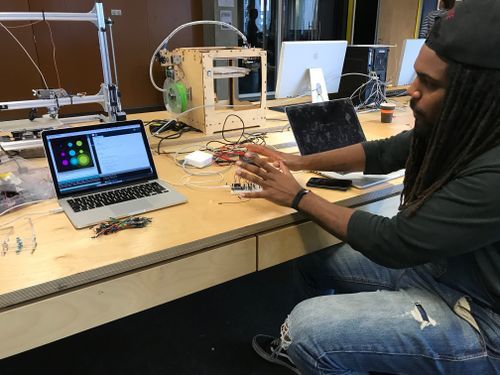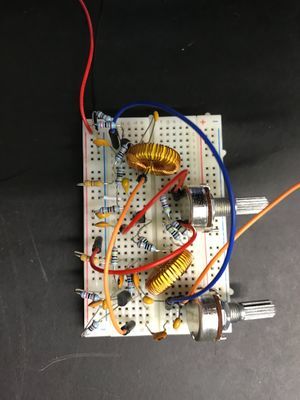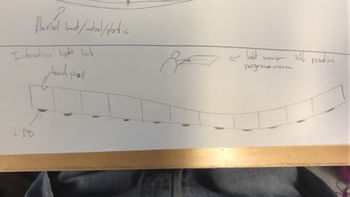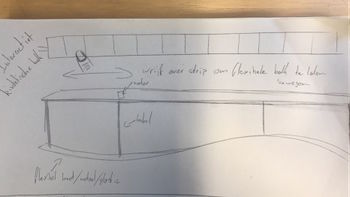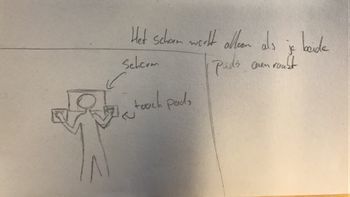Difference between revisions of "User:Kenah/Sensative trackpad"
| Line 2: | Line 2: | ||
<span style='width:40em;font-size:30px;display:block;color:white;background:linear-gradient(purple,white);'> | <span style='width:40em;font-size:30px;display:block;color:white;background:linear-gradient(purple,white);'> | ||
<br/><br/><br/> | <br/><br/><br/> | ||
| − | ''' | + | '''Sensors and sensitivity |
''' | ''' | ||
<br/><br/><br/><br/> | <br/><br/><br/><br/> | ||
| Line 24: | Line 24: | ||
<br/> | <br/> | ||
== PROCESS == | == PROCESS == | ||
| − | + | <br/><br/> | |
| + | ====BODYVOLTAGE METER==== | ||
<span style='width:40em;display:block;'> | <span style='width:40em;display:block;'> | ||
| − | At first, we were assigned to do some digging and bring a sensor to the class. I did some research and found some interesting sensors, like the Bend sensor, pressure Sensor, thermal sensor, proximity sensor and the optical sensor. but the one that got my attention was the body voltage meter. what I think is so interesting about the body voltage meter is that you use your body as a sensor to sense static electricity. <br | + | At first, we were assigned to do some digging and bring a sensor to the class. I did some research and found some interesting sensors, like the Bend sensor, pressure Sensor, thermal sensor, proximity sensor and the optical sensor. but the one that got my attention was the body voltage meter. what I think is so interesting about the body voltage meter is that you use your body as a sensor to sense static electricity. <br> |
[[https://www.youtube.com/watch?v=nVFdMZlHPuM| Body Voltage Meter]] | [[https://www.youtube.com/watch?v=nVFdMZlHPuM| Body Voltage Meter]] | ||
| − | <br><br> | + | <br/><br/> |
In the class meeting where we presented the sensors, I teamed up with Philip. here we decided to do some more research on the body voltage meter plus capacitive sensor. but eventually, Philips research had more information that we could work with. I couldn't find any information oh how or why a body voltage meter did what it did. All I could find is a community that lived with the fear of having static electricity collected in their body because of the daily use of electronics. after exchanging the findings we decided to work with the capacitive sensor. <br> | In the class meeting where we presented the sensors, I teamed up with Philip. here we decided to do some more research on the body voltage meter plus capacitive sensor. but eventually, Philips research had more information that we could work with. I couldn't find any information oh how or why a body voltage meter did what it did. All I could find is a community that lived with the fear of having static electricity collected in their body because of the daily use of electronics. after exchanging the findings we decided to work with the capacitive sensor. <br> | ||
[[https://www.youtube.com/watch?v=lUw1u1PYmBE| People that use it]] | [[https://www.youtube.com/watch?v=lUw1u1PYmBE| People that use it]] | ||
| − | <br><br> | + | </span> |
| + | |||
| + | <br/><br/> | ||
| + | ====CAPACITIVE SENSOR==== | ||
| + | <span style='width:40em;display:block;'> | ||
A capacitive sensing is not the same but allows you to measure proximity and/or touch. This happens by moving your hand through a magnetic field generated by the sensor. Your body is then the other side of a capacitor, changing the capacitance which you can measure. This number can be converted to distance. This requires lots of calibration and filtering the measured values. | A capacitive sensing is not the same but allows you to measure proximity and/or touch. This happens by moving your hand through a magnetic field generated by the sensor. Your body is then the other side of a capacitor, changing the capacitance which you can measure. This number can be converted to distance. This requires lots of calibration and filtering the measured values. | ||
| + | <br/><br/> | ||
| + | [[File:Capacitivetest1 philip.jpg|thumb||center|500px|testing the capacitive sensor]] | ||
| + | </span> | ||
| + | <br/><br/> | ||
| + | |||
| + | ====THERAMIN==== | ||
| + | <span style='width:40em;display:block;'> | ||
| + | Part of Philips research also involved sound so he wanted to find a way to incorporate it. He did a lot of experiment with sound and what kind of visuals it would make (link to [[http://digitalcraft.wdka.nl/wiki/User:Philip#Week_3_.26_4_-_Sensors_and_sensitivity Philip's research]]). After getting the capacitive sensor te work we decided to also try something else, because the capacitive sensor could be really unstable at times. So we tried something else that worked the same but also worked with sound. we started looking at the theremin and eventually build one. the only problem was that we couldn't figure out how to make it work. after consulting with some teachers and a classmate that also worked on one, we decided that it would be best if we would continue with the capacitive sensor. This because the schematics for the theremin were incomplete or wrong. | ||
| + | <br/><br/> | ||
| + | [[File:Theremin philip.jpg|thumb|300px|center|circuit for the theramin]] | ||
</span> | </span> | ||
| + | <gallery widths=350px heights=350px> | ||
| + | File:Capacitivesketch3 philip.jpg|A long beam with LED's that react to (almost) touching a specific part of the beam. | ||
| + | File:Capacitivesketch2 philip.jpg|An interactive kinetic installation that has a long flexible beam that you can move by sliding your hand over a slider. | ||
| + | File:Sketchcapacitive philip.jpg|Two touchpads with a screen in between that forces you to watch the content. | ||
| + | </gallery> | ||
</center> | </center> | ||
Revision as of 18:08, 1 November 2017
Sensors and sensitivity
PEOPLE
ALKENAH WANSING
Major // graphic design
PAGE ALKENAH
PHILIP GHERING
Major // CMD
PAGE PHILIP
SENSOR
BODY VOLTAGE METER
PROCESS
BODYVOLTAGE METER
At first, we were assigned to do some digging and bring a sensor to the class. I did some research and found some interesting sensors, like the Bend sensor, pressure Sensor, thermal sensor, proximity sensor and the optical sensor. but the one that got my attention was the body voltage meter. what I think is so interesting about the body voltage meter is that you use your body as a sensor to sense static electricity.
[Body Voltage Meter]
In the class meeting where we presented the sensors, I teamed up with Philip. here we decided to do some more research on the body voltage meter plus capacitive sensor. but eventually, Philips research had more information that we could work with. I couldn't find any information oh how or why a body voltage meter did what it did. All I could find is a community that lived with the fear of having static electricity collected in their body because of the daily use of electronics. after exchanging the findings we decided to work with the capacitive sensor.
[People that use it]
CAPACITIVE SENSOR
A capacitive sensing is not the same but allows you to measure proximity and/or touch. This happens by moving your hand through a magnetic field generated by the sensor. Your body is then the other side of a capacitor, changing the capacitance which you can measure. This number can be converted to distance. This requires lots of calibration and filtering the measured values.
THERAMIN
Part of Philips research also involved sound so he wanted to find a way to incorporate it. He did a lot of experiment with sound and what kind of visuals it would make (link to [Philip's research]). After getting the capacitive sensor te work we decided to also try something else, because the capacitive sensor could be really unstable at times. So we tried something else that worked the same but also worked with sound. we started looking at the theremin and eventually build one. the only problem was that we couldn't figure out how to make it work. after consulting with some teachers and a classmate that also worked on one, we decided that it would be best if we would continue with the capacitive sensor. This because the schematics for the theremin were incomplete or wrong.
